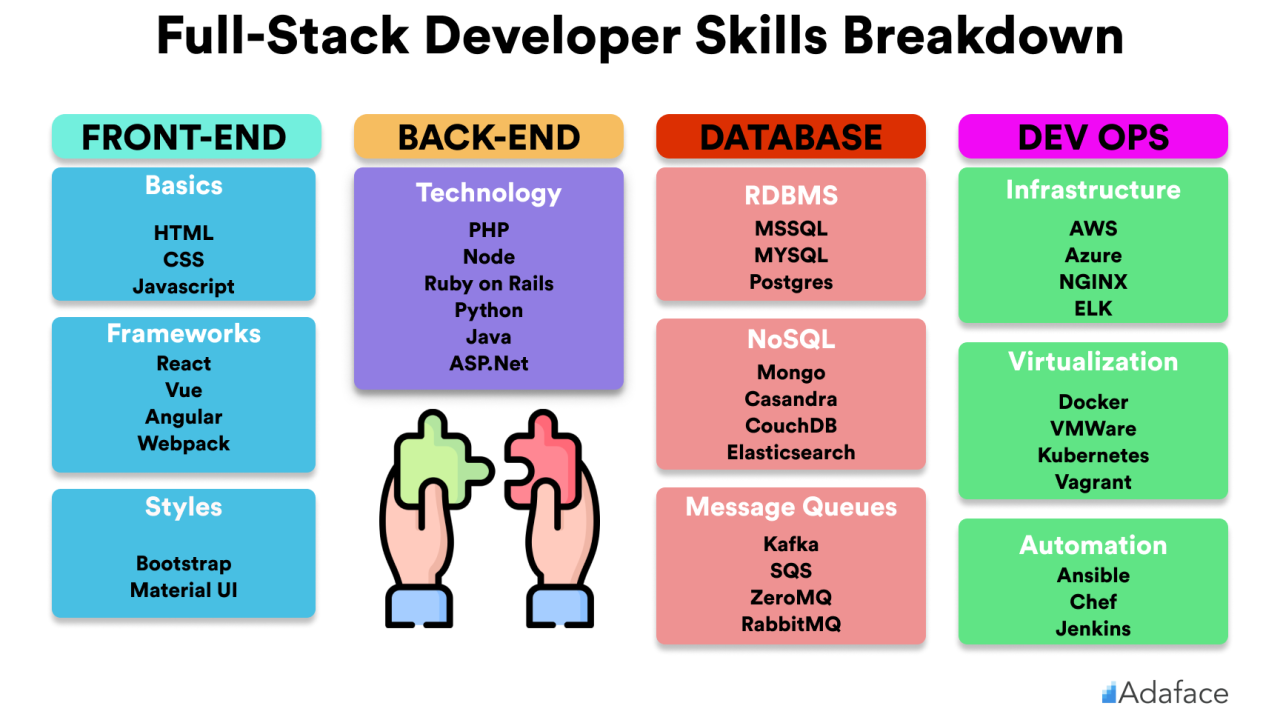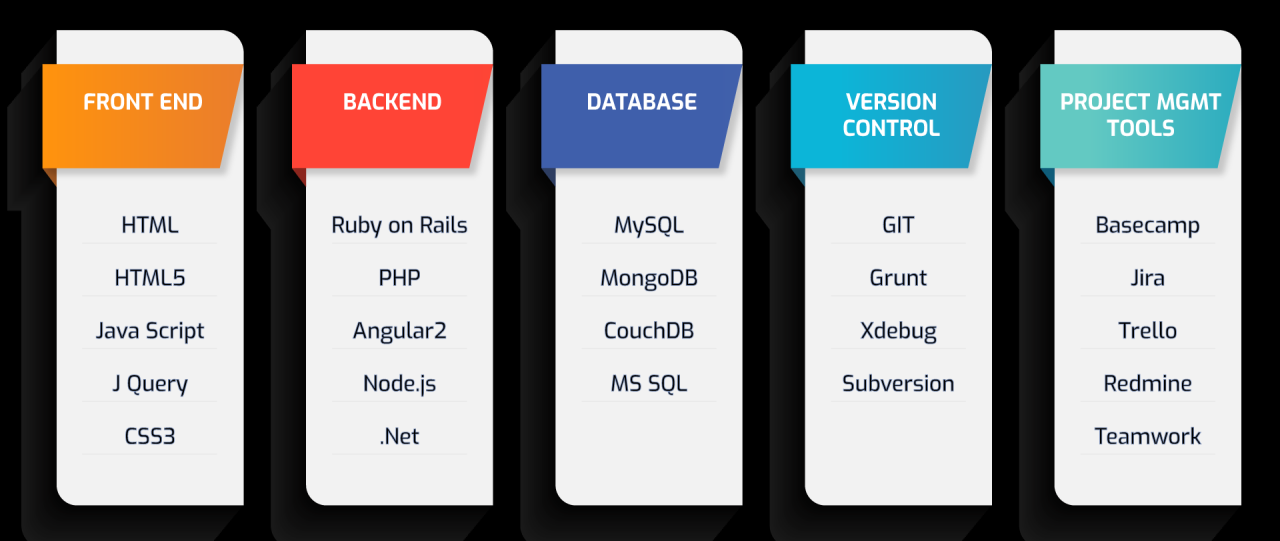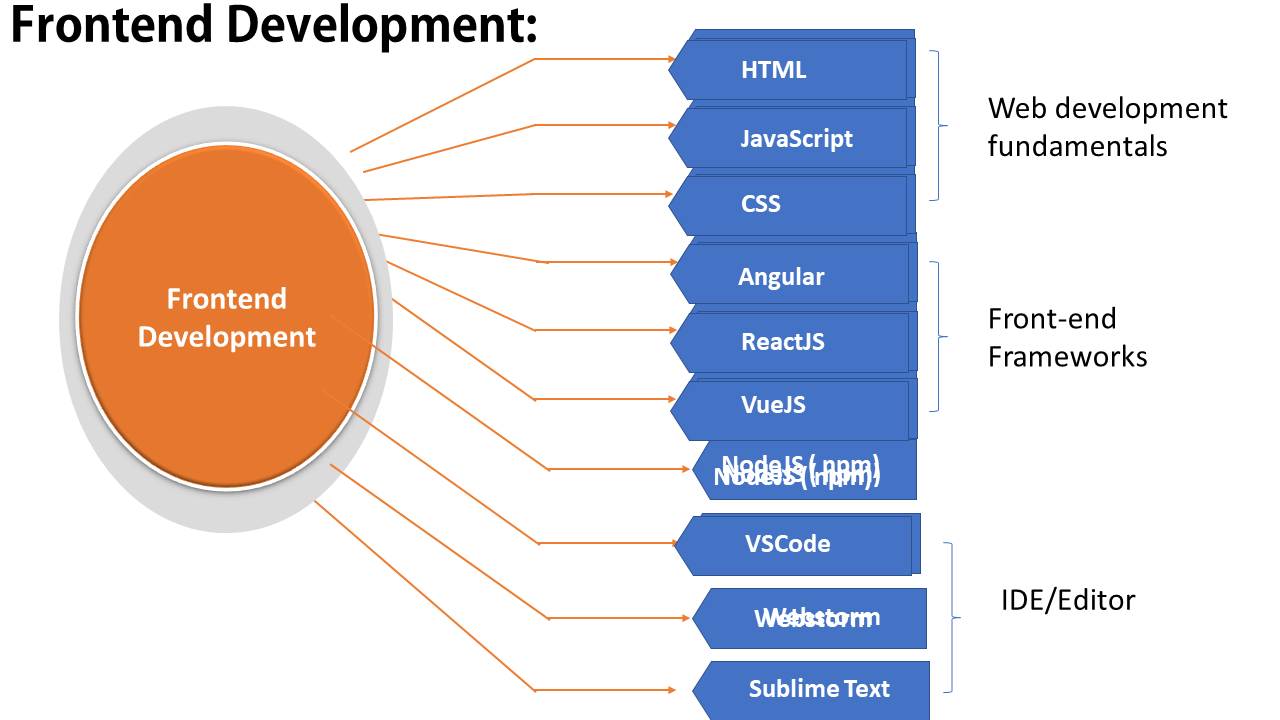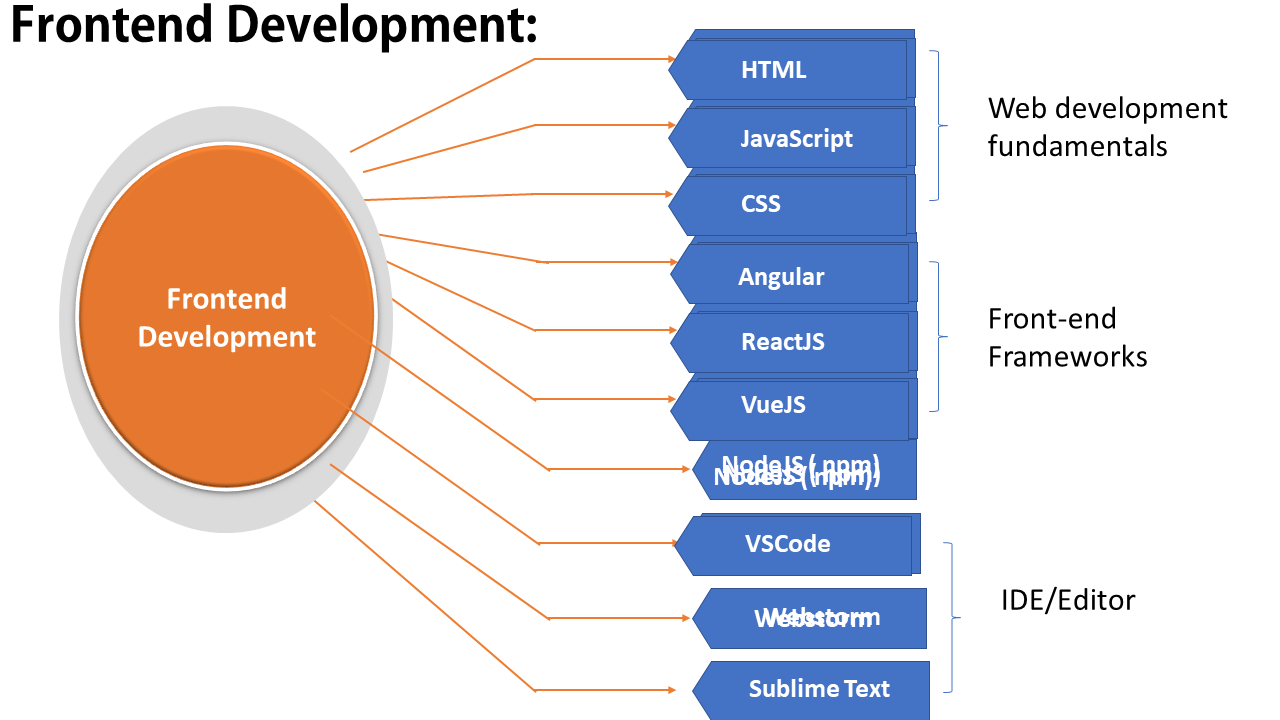Full Stack Developer Career Path and Required Skills: Want to build entire websites and applications from scratch? This journey explores the exciting world of full-stack development, covering everything from front-end design to back-end logic and database management. We’ll map out a clear career path, highlight essential skills, and equip you with the knowledge to launch your full-stack development career.
Get ready to dive into the code!
Becoming a successful full-stack developer requires a blend of technical expertise and soft skills. This guide breaks down the key areas you’ll need to master, from mastering HTML, CSS, and JavaScript to understanding back-end languages like Python or Node.js and database management systems. We’ll also cover crucial aspects like version control, deployment, and the importance of continuous learning in this ever-evolving field.
Introduction to the Full Stack Developer Career Path
A full-stack developer is a versatile programmer proficient in both front-end and back-end development. This means they can handle everything from the user interface (UI) to the server-side logic and database interactions. This role offers a broad skillset and a wide range of career opportunities.
The career progression often starts with specializing in either front-end or back-end development, gradually expanding skills to encompass the full stack. Juniors may focus on specific technologies, while seniors take on more architectural and leadership responsibilities, often mentoring junior developers. Experienced full-stack developers might even lead teams or transition into management roles.
So you’re thinking about a full stack developer career path? It’s a demanding but rewarding field requiring skills in front-end, back-end, and database technologies. However, if that path seems too intense right now, maybe explore other options like healthcare; you could check out surgical tech programs near me with financial aid options to see if that’s a better fit for your current goals.
Ultimately, choosing a career path depends on your interests and aptitudes, so weigh your options carefully before committing to a full stack developer’s demanding workload.
Full-Stack Development Specializations
While the term “full-stack” implies a broad skillset, developers often specialize in certain areas. Some common specializations include mobile app development (using frameworks like React Native or Flutter), game development (utilizing engines like Unity or Unreal Engine), or focusing on specific technologies like MEAN stack (MongoDB, Express.js, AngularJS, Node.js) or MERN stack (MongoDB, Express.js, React, Node.js).
Essential Front-End Skills
The front-end, what users directly interact with, relies heavily on HTML, CSS, and JavaScript. Mastering these is crucial for creating engaging and functional user interfaces.
Core Front-End Technologies
- HTML (HyperText Markup Language): Forms the structure and content of web pages. Think of it as the skeleton.
- CSS (Cascading Style Sheets): Styles the HTML elements, controlling layout, colors, fonts, and responsiveness. This is the skin and clothing.
- JavaScript: Adds interactivity and dynamic behavior to web pages. It’s the muscle and brain, making things happen.
Responsive Design and Cross-Browser Compatibility
Responsive design ensures websites adapt seamlessly to different screen sizes (desktops, tablets, mobiles). Cross-browser compatibility means the site functions correctly across various browsers (Chrome, Firefox, Safari, Edge).
Simple Webpage Example
A basic webpage might include an HTML structure defining headings, paragraphs, and images; CSS styling these elements; and JavaScript adding features like a simple animation or form validation. For example, a button might change color on hover (using CSS) and trigger an alert message (using JavaScript) when clicked.
Back-End Development Fundamentals

The back-end handles the server-side logic, databases, and APIs. Several popular languages and technologies power this crucial part of web development.
Popular Back-End Languages
Python, Node.js (JavaScript), and Java are widely used. Python is known for its readability and extensive libraries, Node.js leverages JavaScript for both front-end and back-end, while Java offers robustness and scalability. The choice depends on project requirements and developer preferences.
The Role of Databases
Databases store and manage application data. SQL databases (like MySQL, PostgreSQL) use structured query language, while NoSQL databases (like MongoDB, Cassandra) offer more flexibility for unstructured data. The choice depends on the data structure and application needs.
Front-End and Back-End Interaction
A conceptual diagram would show a user interacting with the front-end (browser). The front-end sends requests to the back-end (server), which processes the request, interacts with the database, and sends a response back to the front-end for display to the user. This interaction usually involves APIs (Application Programming Interfaces).
Want to be a full-stack developer? It’s a challenging but rewarding path requiring skills in front-end (HTML, CSS, JavaScript) and back-end (databases, server-side languages). To get started, check out some great resources like top-rated IT courses for beginners with career guidance to build your foundation. Then, focus on mastering frameworks and APIs to round out your full-stack abilities.
Database Management and API Interaction
Understanding databases and APIs is vital for full-stack development. This involves choosing the right database type and efficiently interacting with APIs to retrieve and manage data.
Relational vs. Non-Relational Databases

Relational databases (SQL) organize data into tables with relationships between them, ensuring data integrity. Non-relational databases (NoSQL) are more flexible and scalable, handling various data types without rigid structure.
Database Schema Design
Designing a database schema involves defining tables, columns, data types, and relationships. For a simple blog application, you might have tables for users (with fields like username, password, email), posts (with title, content, author ID), and comments (with post ID, user ID, and comment text).
Interacting with a RESTful API, Full stack developer career path and required skills
A RESTful API uses HTTP methods (GET, POST, PUT, DELETE) to interact with resources. Using Python’s `requests` library, you can send requests to an API endpoint, receive JSON responses, and process the data.
| API Call | HTTP Method | Response Code | Data Structure (Example) |
|---|---|---|---|
| /users | GET | 200 OK | ["id": 1, "username": "user1", "id": 2, "username": "user2"] |
| /users | POST | 201 Created | "id": 3, "username": "user3" |
Version Control and Collaborative Development
Git is essential for managing code changes and collaborating effectively on projects. It tracks modifications, allowing for easy rollback and merging of changes from multiple developers.
Using Git for Collaborative Projects
- Initialize a Git repository:
git init - Stage changes:
git add . - Commit changes:
git commit -m "Your commit message" - Create a remote repository (e.g., on GitHub or GitLab)
- Push changes to the remote:
git push origin main - Pull changes from the remote:
git pull origin main - Resolve merge conflicts if necessary
Code Reviews and Collaborative Workflows
Code reviews help identify bugs and improve code quality. Collaborative workflows, such as Gitflow, provide structured branching strategies for managing features and releases.
Deployment and DevOps Practices: Full Stack Developer Career Path And Required Skills
Deploying a web application involves making it accessible to users. DevOps practices streamline this process, improving efficiency and reliability.
Deploying to a Cloud Platform

Deploying to AWS, Google Cloud, or Azure involves setting up servers, configuring databases, and deploying code using tools like Docker and Kubernetes. The specific steps vary depending on the platform and application.
So you want to be a full-stack developer? Awesome! That means mastering front-end and back-end technologies, plus databases and APIs. But remember, understanding the business side is crucial for success – knowing how to build something people actually want and need. This understanding helps you prioritize features, understand user needs, and ultimately, build a more impactful and successful application.
DevOps Practices
DevOps emphasizes collaboration between development and operations teams. Practices like continuous integration (CI) and continuous deployment (CD) automate the build, test, and deployment processes, leading to faster releases and improved quality.
Deployment Strategies
Different strategies exist, including continuous integration/continuous deployment (CI/CD), rolling deployments (gradually updating servers), and blue/green deployments (switching between live and staging environments).
Essential Soft Skills for Full-Stack Developers
Technical skills are important, but soft skills are equally crucial for success as a full-stack developer. These skills contribute to effective teamwork and problem-solving.
Crucial Soft Skills
- Communication: Clearly conveying ideas, both verbally and in writing, is essential for collaboration.
- Teamwork: Working effectively with others is key in a collaborative development environment.
- Problem-solving: Identifying and resolving technical issues efficiently is a daily task.
Continuous Learning and Staying Updated
The tech landscape constantly evolves, requiring continuous learning and adaptation to new technologies and frameworks. Regularly exploring new tools and attending workshops are crucial.
Effective Communication and Collaboration
Strategies include using clear and concise language, active listening, providing constructive feedback, and utilizing collaborative tools like Slack or Microsoft Teams.
Building a Portfolio and Job Search Strategies
A strong portfolio showcasing your skills is vital for landing a full-stack developer job. Effective job search strategies increase your chances of success.
Sample Portfolio Website

A portfolio website should include a brief introduction, a list of projects, and contact information. Each project description should highlight technologies used, challenges faced, and solutions implemented.
Successfully implemented a responsive e-commerce website using React, Node.js, and MongoDB, resulting in a 20% increase in conversion rates.
Networking and Job Search
Networking through online communities (like Stack Overflow, GitHub), attending meetups, and reaching out to recruiters can significantly aid your job search.
Effective Resumes and Cover Letters
Tailor your resume and cover letter to each job description, highlighting relevant skills and experiences. Quantify achievements whenever possible.
So you’re thinking about a full stack developer career path? It’s a rewarding but challenging journey requiring skills in both front-end and back-end development. To really understand what that entails, check out this resource on becoming a full stack developer to get a clearer picture. Mastering languages like JavaScript, Python, and SQL, along with frameworks like React or Node.js, is key to navigating this path successfully and landing your dream job.
Your full stack developer career path will be greatly enhanced with solid foundational knowledge.
Advanced Topics and Specializations
Beyond the fundamentals, several advanced areas and specializations exist within full-stack development. These offer opportunities for growth and expertise.
Advanced Topics
- Security: Implementing secure coding practices to protect against vulnerabilities.
- Performance Optimization: Improving application speed and efficiency.
- Testing: Writing unit, integration, and end-to-end tests to ensure code quality.
Specializations
Mobile development (using React Native, Flutter), game development (using Unity, Unreal Engine), and specializing in specific frameworks (like React, Angular, Vue.js) are examples of advanced specializations.
Comparison of Full-Stack Frameworks
| Framework | Popularity | Learning Curve | Community Support |
|---|---|---|---|
| React | High | Moderate | Excellent |
| Angular | High | Steeper | Good |
| Vue.js | High | Easier | Good |
Last Recap
Mastering the full-stack developer career path is a rewarding journey that combines creativity and technical prowess. By consistently building your skills, expanding your knowledge, and honing your collaborative abilities, you’ll be well-positioned for a fulfilling and in-demand career. Remember, continuous learning is key in this rapidly evolving field – embrace the challenge, build amazing things, and enjoy the ride!
Q&A
What’s the average salary for a full-stack developer?
Salaries vary widely based on experience, location, and company size. Expect a range, but research specific locations for better estimates.
How long does it take to become a full-stack developer?
It depends on your prior experience and learning pace. Dedicated study and practice could take anywhere from 6 months to several years.
Which full-stack framework should I learn first?
There’s no single “best” framework. React, Angular, and Vue.js are popular choices; choose one based on your learning style and project goals.
What are some good resources for learning full-stack development?
Online courses (Coursera, Udemy, freeCodeCamp), bootcamps, and official documentation are excellent resources.
